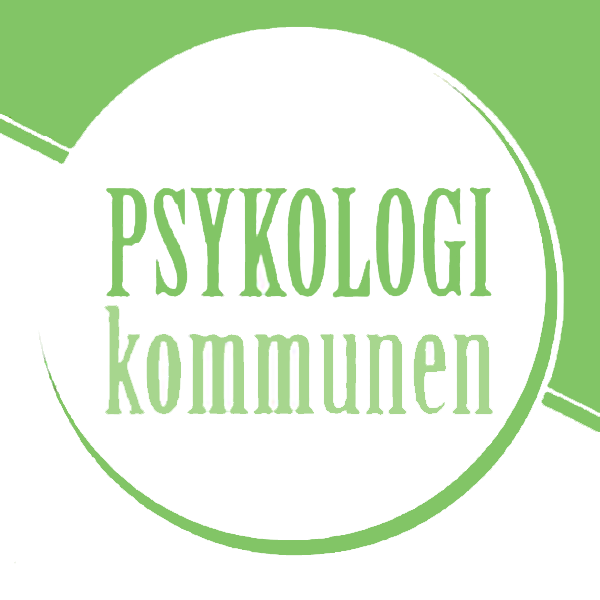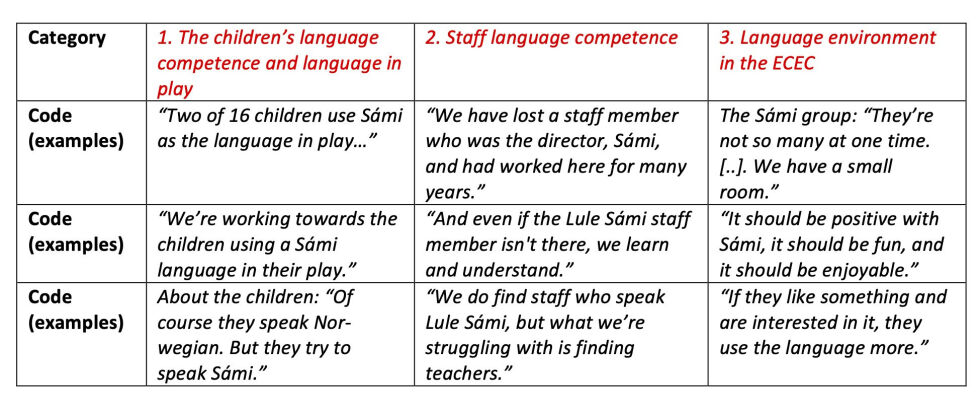Fagfellevurdert
Language revitalization in Sámi Early Childhood Education and Care institutions
Psykologi i kommunen nr. 4 2022
Av: Monica Bjerklund og Ingvild Åmot
Publisert: 30.09.2022 kl 13:18
Summary
The aim of this study in seven Sámi Early Childhood Education and Care institutions (ECECs) is to explore how we can understand language revitalization strategies in Sámi ECECs in the light of socio-cultural theories on human learning. The ECEC staff informants point to the important role the Sámi language has in their everyday practice, and to its role in children’s psychosocial development. They highlighted language revitalization in relation to children’s language competence in general, language in play, the staff’s language competence and the language environment in the ECECs. The Sámi ECECs have tried to create an environment for language revitalization based on the children’s participation, social interaction, play, and previous experiences. In some of the ECECs the staff speak less Sámi than some of the children. To stimulate language revitalization, it will be important for the children, according to Vygotsky (1978, p. 86), to communicate with staff who are more proficient in Sámi than they are. To be able to supervise and/or work together with Sámi-speaking ECECs, it is essential that the Educational-Psychological Services (EPS) staff have knowledge of the practices and possibilities for language revitalization.
Introduction
Based on a qualitative study of Sámi Early Childhood Education and Care institutions (ECECs) in Norway, the article discusses Sámi language revitalization in everyday practice in Norwegian ECECs from a socio-cultural perspective. A total of 711 children attended Sámi ECECs in Norway in 2020 (SSB 2020). Children in Sámi ECECs in Norway have the right to preserve and develop their language skills, knowledge, and culture (Framework Plan for Kindergartens, 2017).
Background, purpose and research question
Article 108 of the Norwegian Constitution grants the Sámi and Norwegian languages equal status (Dagsvold et al., 2015, p. 2). Even so, the Sámi language is under threat, and to protect it, language revitalization, where an extinct language is taken into active use, is needed (Sarivarra et al., 2013, p. 13). Family and educational institutions play a key role in this language revitalization (Hinton, 2018) that can follow many paths. A major part of this is the creation of new speakers – which makes the focus on early childhood relevant.
A majority of children in Sámi ECECs do not come from homes where the Sámi language is actively in use, but some will have a degree of language support, or at least hear some Sámi from their grandparents (Solstad & Nylund, 2015, p. 12-13). This means that ECECs must take on the role of revitalizing the Sámi language. As endangered languages frequently have few resources available to them when it comes to adequate pedagogical materials or teachers fully competent in the language, new strategies for language teaching and learning have been developed to meet the language revitalization goals (Hinton, 2011). According to Hinton, a number of programmes have been developed to address this need. To give adequate services, help, and advice to Sámi ECECs and ECECs with Sámi children, it is crucial that the Educational-Psychological Services (EPS) and other local agencies are aware of the language challenges and why language revitalization is important.
In our research we focus on the daily pedagogical practice in Sámi ECECs and from this work we have formulated the research question for this article:
How can language revitalization strategies in Sámi ECECs be understood in the light of socio-cultural theories on human learning?
To answer this question, we will first present some facts and research on Sámi language revitalization with support from socio-cultural theories on language learning. This will be followed by the presentation of relevant data from seven ECECs: two Lule Sámi, two South Sámi and three North Sámi ECECs, before we address our research question in the discussion.
Sámi languages
The Sámi community comprises approximately 60–80,000 people. Their traditional living area, Sápmi, covers the northernmost parts of Norway, Sweden, Finland and Russia. The Sámi are an indigenous people as defined by the ILO (International Labour Organization), and the Sámi culture and language are protected under the law (Pietikäinen, 2014, p. 479). There are three main versions of the Sámi language spoken in Finland, Norway, Sweden and Russia (Riddi Riđđu, 2013):
1) North Sámi 30,000 – definitely endangered
2) Lule Sámi 2,000 – severely endangered
3) South Sámi 500 – severely endangered (UNESCO 2020)
While UNESCO’s statistics might not be totally accurate, they are neither more nor less reliable than other sources (Johansen et al., 2019, p. 95). Given that Lule Sámi, South Sámi, and North Sámi are official languages in Norway, special attention is given to ensuring equitable treatment of the two minority Sámi languages, Lule Sámi and South Sámi, in Sámi ECECs. The conditions for language learning in different parts of Sápmi vary considerably. The data material in this article covers all three language versions. North Sámi is spoken in Norway, Sweden, and Finland, and 90 percent of Sámi language speakers are North Sámi speakers. It is the most accessible language, and is found in most of Sámi literature, news, and other teaching material for Sámi as a foreign language (Arctic Council, 2019). Among other areas, Kautokeino, Karasjok, Alta, Tromsø, Porsanger, Nesseby, Oslo and Tana have North Sámi ECECs. Lule Sámi is spoken in Sweden and Norway, but most speakers live in Sweden (Arctic Council, 2019). The municipalities of Bodø and Hamarøy in Norway have a Lule Sámi ECEC/ECEC division. South Sámi is spoken in Norway and Sweden. It is the most endangered of the Sámi languages in Norway (Arctic Council, 2019). The Norwegian municipalities of Røyrvik, Snåsa, Røros and Trondheim have a South Sámi ECEC where the language is spoken.
Post-colonial governments often aim to revitalize the indigenous languages that their imperialist predecessors tried to eradicate, the important question is whether they exclude or include the non-indigenous majority in the revitalization process. A study of government policy of language revitalization in New Zealand (Māori) and Norway (Sámi) has found that neo-traditionalism and biculturalism are two poles on an ideological continuum of policy frameworks on language revitalization. Neither of the two approaches has resulted in greater language revitalization, but it appears that New Zealand’s biculturalism approach to Māoris has normalized the indigenous language to give it more goodwill from the non-indigenous polity than in neo-traditionalist Norway. In Norway, the Sámi languages and policy are territorialized and invisible (Alburu 2014).
Sámi language ECECs in Norway
Sámi ECECs operate under different conditions, where Solstad and Nylund (2015, p. 12-13) identify three types of Sámi ECECs:
1) Sámi dominant: the ECEC staff are fluent Sámi language users. The children come from homes where parents speak Sámi and are in contact with other Sámi speakers or live in local communities where the Sámi language is used (Solstad & Nylund, 2015, p. 12-13).
2) Bi-lingual: Here the ECEC staff speak Sámi and the children Norwegian.
3) Norwegian dominant: These ECECs are qualified to receive a grant to facilitate Sámi language learning. Some Sámi divisions in Norwegian ECECs lack Sámi-speaking staff. These ECECs also have a mix of Sámi and non-Sámi children who speak a limited amount of Sámi. Sámi children in Norwegian-dominant ECECs are a minority, and the Norwegian language is the language of the local community (Solstad & Nylund, 2015, p. 12-13).
The main challenge for Sámi ECECs is in recruiting language teachers or promotors (Solstad & Nylund, 2015, p. 12-13, Hinton, 2011). In the Lule Sámi and South Sámi areas, there are far too few persons with ECEC education and Sámi language skills, and there is great competition to recruit them both amongst ECECs and in other professions, such as the media. There is therefore a great need to educate more Sámi ECEC teachers. In North Sámi municipalities, there are usually several language speakers, and as the Sámi-speaking group is thus larger there are more people to recruit as teachers and promoters. Guovdageaidnu–Kautokeino has good access to personnel with Sámi language competence and reports little recruitment problems for the ECECs (Angell et al., 2022). Sámi languages are endangered because of historically aggressive assimilation policies, and hence Sámi communities are working actively on language revitalization. A Swedish study found that the presentation of functional bilingualism in policy documents does not support Sámi as a fully functional language in all parts of society. Children’s right to develop functional bilingualism is encouraged but not supported sufficiently in the curriculum. This is a form of structural discrimination (Belancic & Lindgren 2020). Revitalizing Sámi languages is a difficult task:
When transmission of a language is interrupted, children grow up without the ethnic language of their family and community. A group of children of this kind is sometimes called the lost generation. […] Although language revitalization has gained momentum, the lost generation is still felt like a tragedy on both the individual and collective levels. Rebuilding the lost generation will take many generations, and reclaiming the Sámi languages should be understood as a constant need (Pasanen 2020).
This makes language revitalization important in ECEC settings.
Sámi-speaking staff
Adult language education is an important source for language revitalization (Hinton, 2018). Parents, the ECEC staff, and the local community are parts of the child’s language environment (Heltai & Bartha, 2017, p. 7). Hammine et al. (2019, p. 1) found that indigenous teachers appear to express their professional identities strongly despite their challenging acquisition experiences and are inclined to promote the future of the Sámi languages. Moreover, non-indigenous teachers are willing to develop the Sámi languages even though they are not indigenous, which will perhaps contribute to the future of the Sámi languages. A variety of methods is needed to learn Sámi, for example increased use of the language by native speakers and learners alike (Hinton, 2018).
Language revitalization is a process that demands “strong motivation and courage at the individual level” (Sarivarra 2013, p. 13). According to Hammine et al. (2019, p. 1), teachers narrated complex thoughts about language acquisition and their professional identity and helped develop indigenous language education in their respective indigenous communities.
According to Angell et al. (2022, p. 36) it is somewhat easier to find people with ECEC education and Sámi cultural competence than to find those who also know the Sámi language. The most difficult task is to find staff who know the South Sámi language and Lule Sámi language. There is quite simply almost no one with the skills who can be recruited.
Strategies to promote language revitalization in ECECs
Active cooperation between the participants (children, ECEC staff, the family, the extended family and broader community), alignment with local needs and resources, and flexibility in language practices are crucial factors for successful education and promotion of the indigenous language outside the Sámi homeland (Heltai and Bartha, 2017, p. 7). We point out three important strategies: a) language nest, b) language promoter and c) the role of parents.
One recommended method for promoting language revitalization is to use language nests: all-day ECEC systems where educators use the endangered language with the children throughout the day, regardless the level of the children’s language competence. The language learning occurs during everyday activities in which members of the local community often participate. While the children might use the dominant language, they are motivated to use the non-dominant language. As time passes, they start to use the language outside the language nest (Heltai and Bartha, 2017, p. 10-11). A study concluded that children familiarize themselves with the Sámi culture and learn some Sámi in the language nests, but they are not sufficient on their own for achieving revitalization. Places where the indigenous people can use their language, and promote and practise their culture are also needed (Laihi, 2017).
One study showed that even in Sámi dominant ECECs the staff had to stimulate the children to speak Sámi instead of Norwegian (Solstad & Nylund, 2015, p. 12-13). Norwegian was most commonly used when the children were not proficient enough in Sámi or were very tied to the popular culture. In all the ECECs, the strategy is for the staff to be involved with the children and interact with them using Sámi. A language promoter was essential in many of the bi-lingual ECECs, according to the director, staff, and parents. The language promoter is a strong language user who is an important support for staff who are not as strong in the Sámi language.
According to Pasanen et al. (2022), Sámi children’s productive Sámi skills require a monolingual, Sámi-speaking environment. Facilitating monolingualism in a multilingual society requires awareness and resources as the pressure from the national languages is so strong and because one must counteract everyday language practices and norms that are common in multilingual societies. It might also be necessary to differentiate the children, placing them in different groups according to their language skills, but this is a question that involves many organizational and practical aspects and is in itself a sensitive area.
Parents of children in ECECs can be one of the keys to indigenous language revitalization (Hinton, 2018), and for this reason might be invited into the institutions, as the extended family might also be. According to Heltai and Bartha (2017, p. 23), one strategy for dealing with the linguistic and ideological differences of the participants in ECECs is active cooperation between them and the extended families. Sometimes this leads to the parents themselves starting to learn Sámi, and the family becomes involved in the group activities.
Children’s playfulness might in philosophical ways sidestep colonial cultures and create ways of thinking that stimulate reflections on and with Sámi traditions. Children’s invitations to follow their stories in play can be seen as a decolonizing gesture that combats colonial oppression, revitalizes the Sámi language, and keeps stories and traditional practices and livelihoods alive (Johansson 2022).
We investigated how the informants in our study revitalize Sámi language in everyday practice in Norwegian ECECs through qualitative research methods.
Method and ethics
Our sample comprises practitioners from Sámi ECECs participating in the project Sámi ECECs as a health-promoting arena. The ECECs strengthen the psychosocial environment for North, South and Lule Sámi children aged four to six. We conducted four focus-group interviews and three individual interviews with staff in seven Sámi ECECs. Our sample, spread all over Norway, comprises both local rural Sámi communities in the north, and ECECs in more urban areas; three urban ECECs (> 20 000 inhabitants) and three rural ECECs (< 5000 inhabitants). Three North Sámi ECECs, two South Sámi ECECs and two Lule Sámi ECECs were included. Sámi ECECs in the 18 municipalities that received support from the Sámi Parliament were contacted to recruit informants. We received a positive response from eight, and due to circumstances related to the covid-19 pandemic, the number was reduced to seven. In all the ECECs we talked to Sámi-speaking staff. All ECEC teachers in general are educated to promote children’s language skills, and therefore we knew this was a skill all the ECEC teachers in our sample had. One ECEC teacher in our sample was non-Sámi-speaking and had to learn the language and rely on an assistant in the language revitalization work. The interviews, lasting from 60 to 90 minutes were conducted in ECECs and in digital meetings (due to Covid-19) by female senior researchers.
The study proposal was approved by the Norwegian Centre for Research Data (NSD) and the project complied with the ethical guidelines established by the National Committee for Research Ethics in the Social Sciences and the Humanities (NESH) (2018). An information and invitation letter, approved by the local authority, was sent to the ECEC directors and distributed to the staff. The staff were anonymous to us until they had given their consent to participate, and the parents consented on behalf of their children. Participation in the study was voluntary.
One researcher is Sámi and the other non-Sámi. Indigenous and Western research paradigms and thinking are different in some essential ways. There are examples of “research that has disempowered communities, imposed stereotypes that reinforce internalized racism and benefitted the researchers’ careers but not provided anything in return to the communities” among some non-indigenous researchers studying the Sami culture (Melbøe et al. 2016, p. 3). Hence, having two researchers from both cultures is a way of addressing some of these differences in cultures and preventing the risk of reinforcing stereotypes. Sámi research “has a history of having the outsider perspective imposed upon them, being researched by others without taking an active part in the research themselves” (Melbøe et al. 2016, p. 3). Therefore, an important ethical principle of research involving indigenous peoples is to include indigenous researchers (Melbøe et al. 2016). Being a non-Sámi researcher taking part in indigenous research supplies the “outsider position” and makes it possible to see practices in new ways, but power relations and colonisation make it important to balance this outsider position with insider positions. There are challenges in being positioned as a white researcher conducting research on indigenous people and perspectives. A decolonial stance might have implications for how a white researcher can approach questions of indigenous people’s circumstances without reinscribing privilege or resorting to self-righteousness (Eriksen 2022). In our acknowledgement of the presence of such risks, we have undertaken a culturally sensitive approach and used a Sámi advisory board in our research. There may be differences between being a member of the majority society who researches minority citizens and having minority experience and an affiliation with indigenous people. A reference group has therefore been a part of this study, and within our research team, we have had several ethical discussions on this topic during the research period.
The main subject in the interviews was Sámi ECECs as health-promoting arenas. The researchers collaborated on analysing the data and writing the article.
In our analysis we have used Stepwise-Deductive Induction within qualitative research as our strategy. This approach aims “at developing concepts, models, or theories on the basis of a gradual paradigm to reduce complexity” (Tjora, 2018) and relies on an inductive principle, meaning that our analysis began with raw data and moved towards concepts or theories through incremental deductive feedback loops (Tjora, 2018).
Due to anonymity concerns, we will not reveal which of the three Sámi languages the extracts are taken from. In this project, it has been necessary to reflect on the educational institutions’ and researchers’ points of view when it comes to Sámi conditions. As non-Sámi-speaking researchers, it has also been important throughout the project to keep historical experiences in mind, where research and the education system have been part of the colonization of the Sámi people (Olsen et al., 2017), and to act respectfully within the complex situations we were a part of.
Theory
Our theoretical framework is socio-cultural theory on language learning (Vygotsky, 1978). When children learn language(s), individuals and the environment influence one another in complex ways. Socio-cultural theories assume that social and emotional development depends on language and communication. Language is important for children’s wellbeing today and in the future (Sheridan & Gjems, 2017).
Language learning takes place when an interpersonal process is transformed into an intrapersonal process in the child. Every function in the child’s cultural development first appears on the social level (inter-psychological), and later, on the individual level, inside the child (intra-psychological) (Vygotsky, 1978, p. 57). In sociocultural constructivism theory, human learning is described as a social process. The child constructs knowledge based on social relations, social experiences, previous experiences, prior knowledge, background knowledge, and sensory experiences. The role of the educator will thus be to facilitate the conditions for this learning. The most important single factor that affects children’s learning is what the child already knows and is capable of. The children’s prior knowledge is the platform on which they stand when starting to understand the outside world and develop a cognitive network (Øzerk, 2008, p. 261).
In a constructivist approach, the educator acknowledges that the children have varied linguistic skills and experiences and bases the education on the child’s different experiences from previous language learning (Øzerk, 2008, p. 268). It focuses on representation, participation, and construction of meaning, where the latter forms the basis for the child’s language development and learning.
Findings
In general, the informants talked about language as essential for a good psychosocial environment in the ECEC. The ECEC staff highlighted the importance of Sámi language skills and the necessity of having a focus on Sámi language throughout the ordinary activities in the ECEC. When we asked the informants how important it was for children to speak Sámi in the ECECs, one of them said:
It’s extremely important. We’re speaking a threatened language. Norwegian dominates in the surrounding community, and you hear Sámi in very few arenas. [...] We feel that if we are to save the language, we have to succeed in the ECEC.
Another informant said it was important that the children were surrounded by the Sámi language: “I think that hearing the language is the most important thing. That they hear it every day. Around them all the time.” This informant added that more Sámi-speaking staff would help the children to learn Sámi. Here our informants connect language revitalization closely to the lack of co-learning possibilities in the surrounding community and the staffs’ language skills.
As we have interviewed Sámi-speaking staff in ECECs in various parts of Norway, it is interesting to note that our findings show the importance of the children’s and staff’s language competence in language revitalization strategies, Sámi language environments, and Sámi language groups.
The children’s language competence
Our informants mentioned how play can facilitate and accentuate Sámi language as a part of the children’s ordinary activities.
We try to lead it in such a way that it’s a fine balancing act. That there is neither too much free play, nor too much adult-controlled play. […] On the days we don’t have language activities we have free play.
We asked one informant whether the children used Sámi as their language in play, and she said:
Yes and no, perhaps two of the 16 use Sámi as their language in play. However, I’m looking at a child who came here and only spoke Sámi, and today only speaks Norwegian. That’s because he hears the Norwegian language the most. However, when he was home he heard Sámi all the time.
She states that as so few children in the ECEC use Sámi language in play it challenges the efforts to revitalize the Sámi language. Another challenge was that some children learn one Sámi language in their ECEC and another at home. When there is only one Sámi ECEC in the area, the parents still choose the Sámi one in spite of the language differences.
The children played in different languages, one informant told us: “Our goal is to have Sámi as the language of their play, but we see that they also often play in Norwegian”. If the staff were very involved in the children’s play, they often influenced them to use Sámi, according to one informant. In one newly established ECEC, Sámi had not become a language of play yet, and the staff wanted to work actively for Sámi to be both a language in conversations and a language in play.
When we asked whether both Sámi and Norwegian were used among the children and between the staff and children in an ECEC with a good number of Sámi staff, one teacher replied:
Our main goal is that the Sámi language should be natural and we’re working to have the children use Sámi language in play too, and that it becomes natural for the children to speak Sámi with each other. Therefore, the criterion is that the adults must be able to speak Sámi with each other and with the children.
In this ECEC, most of the staff were Sámi, in contrast to ECECs where the Sámi language was less used. In our sample, the informant told us that it was difficult to recruit Sámi-speaking staff in ECECs, and especially ECEC teachers.
Staffs’ language competence
Several ECECs were struggling to recruit Sámi-speaking staff, particularly ECEC teachers. Because the ECEC did not have the adequate number of ECEC teachers they were obliged to have according to the law, one of the informants felt that they repeatedly needed to start from scratch. Sometimes the ECEC had Sámi student teachers working there during their practice period. At the time of the interviews, one small ECEC had only one staff member who spoke Sámi, while other staff members attempted to learn some phrases.
The ECECs tried to stimulate non-Sámi employees to learn Sámi. An ECEC teacher who did not speak Sámi stated: “We have put up the [Sámi-language] posters we have been able to obtain. When we’re together, we learn some phrases. We understand what Elsá-Máijá means.” Some staff learnt Sámi from the children and Sámi-speaking staff. This points out that active use of the language and teaching aids such as posters influence staff competence in Sámi – even if only limited to some simple phrases.
Language environment in ECECs
The informants pointed to the language when we asked them what was specifically connected to Sámi culture in their ECEC. One informant said that her aim was for the children to hear Sámi daily even if only one member of staff spoke the language: “I’m there. When I speak to the Lule Sámi children, I speak Sámi, when I address the Norwegians I speak Norwegian. It goes automatically.” She took responsibility and felt she had an important role in the revitalization of the children’s language without finding it a burden to switch between two languages.
One informant found it particularly interesting that when they went outside of the ECEC the language learning accelerated:
We also see that those who have mostly Norwegian at home, based on experience when they are visiting, for example the beach at ebb tide, then they learn the words for kelp and crabs and so on. So they learn these words, and they have them in Sámi.
In this way Sámi language expanded the children’s knowledge base.
Traditional activities such as preparing and smoking reindeer meat were used for language learning in an urban Sámi ECEC.
We taste marrowbones. It was a bit strange. Dumplings with blood. All these things. […] Therefore, this with tongue, marrowbones and dumplings with blood is really the joy of food. In addition, they taste the whole language. Like a pantry.
Here, talking about the activity became a way to learn new terms by connecting the language to concrete objects and giving exposure to cultural practices: “We use naming throughout the institution, in North and South Sámi and Norwegian in the cloakroom. Yes, some artefacts. What we do is named, and then we can say the words.”
In the ECEC, the staff have chosen to try different forms of organization to determine what works best. One ECEC had tried to establish itself as an institution where all the children and adults were able to speak Sámi, but had not been able to achieve this:
We have children from very mixed families, where some have only Sámi at home, some have a mix, and some generally have only Norwegian at home. Over all the years, Norwegian has dominated. [..] Last year we therefore launched something we call language zones.
The language zones are physically marked out spaces using tape on the floor so the children do not need to think about which language strategy to use all the time, and whether it is right to speak Norwegian or Sámi according to which staff members or children are present, the situation, and which games they are playing. The ECEC teacher found it could be strenuous for the children to have to continually choose between strategies.
We asked another ECEC whether they had assessed dividing the Sámi children into one section with Norwegian-speaking children and one with Sámi-speaking children:
Are we supposed to be the ones who have to decide whose Sámi is good enough? That would be unpleasant. I also think this would feel uncomfortable for the parents. [...] Therefore, we have decided that the way to do it is to have everybody together.
The informants pointed out that learning Sámi was to be seen as a source of joy for the children. “It’s the language of the heart, and we want it to reflect the way we work.” This ECEC had arranged for a place where the children could go if they felt they needed to speak Norwegian. On excursions, those who wanted to speak Norwegian had to walk to the back of the line: “Nobody wanted to walk at the tag end, so everybody spoke Sámi.” The reason the ECEC made Norwegian zones was that the children might need to say something important they were unable to say in Sámi. However, at times the ECEC has divided the children into language groups: as Norwegian dominated the most among the older children, the younger ones would quickly change to Sámi.
Sámi group
Several ECECs had a Sámi group where children who spoke Sámi had activities in a group outside the ordinary activities. Here, particular attention was given to speaking Sámi:
Quite early, we found that we needed a separate arena where we could take the Sámi children out of the Norwegian-language group to make a “bubble” where we can speak Sámi without causing too many distractions for the other children.
The staff pointed out that the Sámi group was an important measure for strengthening the language environment in the ECEC. This group approach has several advantages: it raises the competence in Sámi of all the children in the group because of the keener focus, and dividing into groups makes the Sámi language attractive because Norwegian children would also like to join in. One of the staff in an urban ECEC said:
In addition, that we improve the language of other children in the ECEC. Therefore, we have all worked to make being in the Háleštit group [the talk group] something to be proud of. Thus, it isn’t something strange – speaking Sámi and being in the Háleštit group. We talk about how some speak Sámi, and some speak Russian. So that we challenge each other with how many words we know.
In the Háleštit group, or talk group, the ECEC’s annual plan was followed in the same way as in the rest of the ECEC, with “a little extra”. The ECEC switched between having all the children together and attending the Sámi group in small pools. In this way, the Háleštit group appears to be an attractive limited resource in this ECEC, with only one Sámi-speaking staff member and one small room. The informants said that Sámi “permeates the walls” and that language stimulation is an activity that promotes well-being.
Informants said that establishing groups created a reinforced language environment, which the Sámi children would benefit from by having increased attention on the language, a better group feeling, and reinforced identity as Sámi speakers.
Conversations among children in the Sámi group – based on their interests and Sámi objects (toys) – could facilitate language learning, as one informant told us:
I do this particularly in the Háleštit group to focus on the language. Letting them do what they are interested in. If they like something and are interested in it, they use the language more. Now there was particularly one boy who took the initiative to play with it [a snowmobile]. Then the play was mostly in Sámi. In addition, there was some Norwegian-language input in-between.
The child in question here spoke another Sámi language than the one dominant in the ECEC, which is a good example showing that ECECs might vary as to which Sámi language the children speak. The extract points out how focus on a child’s interests and initiatives stimulates the use of the Sámi language. The ECEC teacher explained “He goes a lot with his father up into the mountains, so he’s used to this”, adding that the boy taught vocabulary to the other children in their play.
Discussion
Above we have shown how the ECEC staff point out the important role the Sámi language plays in their everyday practice. Their language revitalization strategies highlighted revitalization in relation to children’s language competence in general, the staffs’ language competence, and the language environment in the ECECs. To be able to supervise and/or work together at a Sámi-speaking ECEC on any occasion, it is essential that the EPS advisor has knowledge of the practices, challenges, and possibilities for language revitalization. Our discussion aims to provide insight into the field by underlining how the described practices can be understood in a socio-cultural perspective, highlighting a) children as active agents and b) the role of the language environment.
Children as language agents in play
Some of the children in our samples were active agents in promoting the Sámi language through their engagement in playgroups. These children were more fluent in Sámi as they took part with their parents in traditional Sámi activities that they then tried to introduce in their play. Thus, the children’s relationships and play might have a role in language revitalization. The children were also agents in creating a sense of coherence between their home activities and the ECECs, as shown with the boy with the snowmobile. Our sample shows a keen focus on children’s participation in the teachers’ didactic approach – supported by socio-cultural views on learning (Øzerk, 2008). According to Vygotsky (1978, p. 88), human learning presupposes a specific social nature and a process through which children grow into the intellectual life of those around them. Moreover, Johansson (2022) considers play to be a source of decolonization, thus combatting colonial oppression and revitalizing Sámi language. This is important because of the historical trauma the Sámi have experienced from the assimilation process (see Belancic & Lindgren, 2020).
One of the ECECs in our sample had a rule to only speak Sámi; in the other ECECs, the children had varying language competence. In a sociocultural perspective, and according to the theory of the zone of proximal development, it would be advantageous that other children on their social level (inter-psychological) expose non-Sámi-speaking children to the language. This might help the children to develop the Sámi language on the individual level (intra-psychological) (Vygotsky, 1978, p. 57). Hence, there is no need for all children to be proficient in Sámi initially. However, it might be difficult for some children if they do not understand the language used by their peers, and for the Sámi-speaking child who must sometimes assume the role of language promotor. Varying levels of language competence might also lead to some children being excluded from play and other social settings.
The children in our study used their prior knowledge of the language in their peer group and spoke Sámi in conversations and co-learning situations (see Øzerk, 2008, p. 268). Participation in traditional Sámi practices at home stimulates children’s language, which then can be imparted to other children in the ECEC. Hence, the children become language agents, not merely passive receivers of the staffs’ language initiatives.
The ECECs as a language environment
Because each function in children’s cultural development first appears on the social level and later on the individual level (Vygotsky, 1978, p. 57), the ECEC is an important language environment. All ECECs in our sample are affected to some degree by limited language resources (staffs’ Sámi skills), and hence must make pragmatic choices to create a good language environment and to create co-pedagogical language activities. The choices differ from one institution to the next, and from Sámi homeland ECECs to urban areas with few Sámi speakers in our sample. Thus, the ECEC staffs’ Sámi skills are important for supporting co-learning.
The staff also manipulated the social environment to make it a better language-promoting arena. All activities in the ECEC institutions in our sample fall under the definition of co-pedagogical activities, i.e. interaction, collaboration, conversation, and co-learning as part of language revitalization (Øzerk, 2008).
Sámi-speaking staff
In our sample we have examined ECECs in terms of two severely endangered languages (UNESCO, 2020), Lule Sámi and South Sámi, in four institutions that have staff who are either non-native Sámi speakers or are non-Sámi speakers. We have interviewed Sámi-speaking staff in all our sample ECECs. With only 2000 and 500 speakers of each language, one quickly understands that it is difficult to recruit ECEC teachers and staff, as Angell et al. (2022) found in their study. This is mainly a structural problem and not due to the staffs’ didactic work on language revitalization. In a few examples, non-indigenous teachers were open to developing their Sámi-language proficiency. Even though they are non-indigenous, these ECEC teachers can contribute to ensuring a future for the Sámi language (e.g., Hammine et al., 2019, p. 1). But, due to the lack of skilled staff, it is not always possible to follow the recommendation of Pasanen et al. (2022) to create a monolingual, Sámi-speaking environment in the ECECs.
The zone of proximal development indicates the level of potential development as determined through problem solving under adult guidance (Vygotsky, 1978, p. 86). In the Sámi ECECs, it might be hard to provide the children with adult guidance in the Sámi language due to the difficulties in recruiting Sámi-speaking staff. We also found situations where staff (and children) educated other staff in an endangered language in the ECECs, teaching them simple words and phrases.
In the ECECs in our study, language revitalization was supplemented by an introduction to cultural practices. This might be a way to strengthen coherence in children’s language learning. Learning that is oriented towards developmental levels that have already been reached is ineffective because it does not aim for a new stage in the developmental process but rather lags behind this process (Vygotsky, p. 86). The best practice would be that the staff in the ECECs are more proficient in Sámi than the children. In some of the ECECs in our sample some of the staff speak less Sámi than some of the children. To stimulate language revitalization, it will be important that children, according to Vygotsky (1978, p. 86), communicate with staff who are more proficient in Sámi than they are. Several of the ECECs in our sample have engaged a Sámi language promotor, and in the urban districts, the ECECs appreciated their language promotor to a very high degree. The zone of proximal development (Vygotsky, 1978, p. 86) and co-learning among staff and children might in these cases be supported by the Sámi language promotor.
To be able to support children’s development in many areas, knowledge of their language is a fundamental skill. According to the Kindergarten Act, section 19 c, the EPS must assist the ECECs in the work on competence and organizational development to tailor the ECEC programme for children with special needs. In this connection it is crucial to be aware of the language challenges and the need for language revitalization. We provide insight here that shows the three main areas (children’s language competence in general, the staffs’ language competence, and the language environment in the ECECs) where Sámi staff emphasise Sámi language learning in a revitalization process.
Co-pedagogical activities, such as interaction, collaboration, conversation, gathering, and co-learning, strengthen language training. Children’s experience of the world, their prior knowledge, and background knowledge must be accounted for pedagogically. The children’s participation in the learning process requires inclusion and the opportunity to articulate their experiences, thoughts and desires (Øzerk, 2008, p. 268).
Summary
Forming opinions is an important part of constructivist approaches to language learning. We do not adopt a passive, receptive attitude towards the world. Children do not acquire linguistic skills and knowledge from the educator without their own processing. People are thinking beings, actively participating in their own language development. Educational institutions must give indigenous children the opportunity to use prior knowledge and background knowledge as a basis for active participation in training processes (Øzerk, 2008, p. 269). To understand language revitalization strategies in Sámi ECECs in the light of socio-cultural theories on language learning, we found that a focus on children’s prior knowledge and background knowledge of the language and on the language used in play, the staffs’ language skills, and the language environment in the ECECs provide important support. Children learn best if the ECEC focuses on their social relations, social experiences, previous knowledge, prior knowledge, background knowledge, and sensory experiences (Øzerk, 2008).
The Sámi ECECs in our sample have tried to create an environment for language revitalization based on the children’s participation, social interaction, play, and previous experiences. There are major differences in the Sámi language areas. The Lule Sámi ECECs inside and outside Sámi areas in Norway have both similarities and differences. They are both struggling to find a sufficient number of Sámi-speaking ECEC teachers and personnel, and the city-based Lule Sámi ECEC is not in the midst of a Sámi-speaking society. The same is the situation in our two South Sámi ECECs. All the North Sámi ECECs in our sample are situated in Norwegian-language dominated areas, but North Sámi is a language for which the ECECs have easier access to Sámi-speaking recruits, according to Angell et al. (2022).
The project Sámi ECECs as a health-promoting arena has been supported by the Sámi National Advisory Service – Mental Health and Substance Use (SANKS).
Literature
Albury, NJ (2015) Your language or ours? Inclusion and exclusion of non-indigenous majorities in Māori and Sámi language revitalization policy. Current Issues in Language Planning, 16:3, 315-334, DOI: 10.1080/14664208.2015.984581
Angell, A, Kårtveit, B, Nygaard, V & Riseth, JÅ (2022) Hvor går veien? Kartlegging av samisk språk og kultur i språkforvaltningskommunene. [Where does the road go? Mapping of Sami language and culture in the language administration municipalities] Rapport 11-2022, NORCE Helse og samfunn.
Arctic Council (2019) The Sámi Languages. https://www.arcticpeoples.com/sagstallamin-the-saami-languages
Bartha, C and Borbála, PH (2017) Ideologies and practices in an ECEC offering early education in North Sámi outside the Sámi homeland. Journal of Applied Language Studies, 11(3), 7–28. DOI: 10.17011/apples/urn.201712104582
Benz C, Bull T, Mittelmark M and Vaandrager L (2014) Culture in salutogenesis: the scholarship of Aaron Antonovsky. Global Health Promotion. 2014;21(4):16-23. Doi:10.1177/1757975914528550
Belancic, K & Lindgren E (2020) Discourses of functional bilingualism in the Sami curriculum in Sweden, International Journal of Bilingual Education and Bilingualism, 23:5, 601-616, DOI: 10.1080/13670050.2017.1396283
Eriksen, K (2022). Decolonial methodology and reflexive wrestles of whiteness. Reconceptualizing Educational Research Methodology, 13(2). https://doi.org/10.7577/rerm.4666
Johansen K, Møllersen S, Rasmussen T, Aslaksen I and Tovmo P (2018) Sámi Statistics Speak. Numbers and Commentary. 1/2018. Raporta/Rapport. Downloaded 6/11/20.
Johansson V (2022) Sámi children as thought herders: philosophy of death and storytelling as radical hope in early childhood education. Policy Futures in Education. 2022;20(3):316-331. doi:10.1177/14782103211031413
Hammine M, Keskitalo P, Katjaana Sarivaara E (2019) Sámi language teachers’ professional identities explained through narratives about language acquisition. The Australian Journal of Indigenous Education. 1–9. https://doi.org/10.1017/jie.2018.22
Hinton, L. (2018) Approaches to and Strategies for Language Revitalization. The Oxford Handbook of Endangered Languages. Edited by Kenneth L. Rehg and Lyle Campbell. https://www.oxfordhandbooks.com/view/10.1093/oxfordhb/9780190610029.001.0001/oxfordhb-9780190610029-e-22
Hinton, L. (2011) Language revitalization and language pedagogy: new teaching and learning strategies. Language and Education Vol. 25(4). 307–318. https://doi.org/10.1080/09500782.2011.577220
Ministry of Education and Research (2005) Kindergarten Act. Act no. 64 of June 2005 relating to Kindergartens. Last amended 1 October 2018. Norwegian Ministry of Education and Research. https://www.regjeringen.no/globalassets/upload/kd/vedlegg/barnehager/engelsk/act_no64_of_june_2005_web.pdf
Ministry of Education and Research (2017) Framework Plan for Kindergartens.
Lahi, T-M (2017) Skolt Sámi Language and Cultural Revitalization: A case study of a Skolt Sámi language nest. Masters Thesis: Helsingfors universitet
Riddi Riđđu (2013) Dån tsamáda tjavgga = You whisper loudly / [all illustrations made by Anders Sunna].Riddu riđđu davvi álbmogiid guovddáš (publisher). Publicerad: [Samuelsberg, Norge]: https://site.uit.no/sagastallamin/files/2020/01/16_RollUp_Sagastallamin_low-res.pdf
Regulations on a framework plan for the content and tasks of Kindergartens. Downloaded 24 Oct. 2020. Lovdata. https://lovdata.no/dokument/SFE/forskrift/2017-04-24-487#KAPITTEL_2
Sarivaara E, Uusiautti, S and Määttä K (2013) How to Revitalize an Indigenous Language? Adults’ Experiences of the Revitalization of the Sámi Language. Cross-cultural Communication. Vol. 9, No. 1, 2013, pp. 13-21. DOI:10.3968/j.ccc.1923670020130901.2121
Solstad M and Nylund I (2015) Sámisk i barnehagen? Ei evaluering av Sametingets tilskuddsordning til barnehager [Sámi language in ECEC. An evaluation of the Sámi Parliament’s appropriations for ECECs.] NF rapport nr.: 2/2015. https://evalueringsportalen.no/evaluering/S��mi sk-i-barnehage-ei-evaluering-av-sametingets-tilskuddsordning-til-barnehager/Ev%20barnehage%20tilskudd.pdf/@@inline
Srikanth S (2020) Indigenous Language Revitalization: An Interview with Professor Ryan DeCaire. The Innis Herald. http://theinnisherald.com/indigenous-language-revitalization-an-interview-with-professor-ryan-decaire?fbclid=IwAR17caGr5q0OHFLLlmZHzepAyJLrj-wn5H0o9lhVWE2mjYIQtvdDafOYaUM
Sheridan S and Gjems L (2017) Preschool as an arena for developing teacher knowledge concerning children’s language learning. Early Childhood Education Journal, 45(3), 347-357. doi:http://ezproxy2.usn.no:2087/10.1007/s10643-015-0756-8
SSB 2020. 06777: Sámi statistics. Sámi kindergartens, kindergartens with Sámi language tuition, children in Sámi kindergartens and children receiving Sámi language tuition 2005 – 2020. https://www.ssb.no/en/statbank/table/06777
Pasanen, A, Päiviö A-M, Baal, BAB, Mikkelsen, ILS (2022) Sterke språkmodeller. [Strong Language models). SAMOS.
Pasanen (2020) New speakers are building a future for the Sámi languages, Published 16 December 2020.
Catedra UNESCO. https://catedra-unesco.espais.iec.cat/en/2020/12/16/51-new-speakers-are-building-a-future-for-the-sami-languages/
Pietikäinen S (2014) Spatial interaction in Sámiland: regulative and transitory chronotopes in the dynamic multilingual landscape of an indigenous Sámi village. International Journal of Bilingualism. 2014;18(5):478-490. doi:10.1177/1367006913484210
The National Committee for Research Ethics in the Social Sciences and the Humanities (NESH) (2018) Guidelines for Research Ethics in the Social Sciences, Humanities, Law and Theology | Forskningsetikk
UNESCO Interactive Atlas of the World’s Languages in Danger (2020) Downloaded 6/11/2020 from: http://www.unesco.org/languages-atlas/index.php
Vygotsky LS and Cole M (1978) Mind in Society: Development of Higher Psychological Processes. Harvard University Press.
Øzerk, K. (2008) Grunnlegggende norsk for språklige minoriteter i lys av en konstruktivistisk læringsteori [Basic Norwegian for language minorities in light of a constructivist learning theory]. In Selj, E. & Ryen, E. (Eds.): Med språklige minoriteter i klassen. Språklige og faglige utfordringer [With language minorities in the classroom. Language and academic challenges]. Oslo: Cappelen Akademisk Forlag.
Kommentarfeltet er stengt.
Fagartikkel Vis flere
Av. Ingvild Sundfør Rasmussen og Hanne Cecilie Braarud
Av: Marie-Lisbet Amundsen og Jens B. Grøgaard
Av: Mette Meidell, Bodil Svendsen og Elin Bø Morud
Fagfellevurdert:
Hvilke faktorer mener unge med ADHD har hatt betydning for at de har klart å gjennomføre videregående utdanning på normert tid?
Psykologi i kommunen nr. 2 2023
Av: Camilla Selmer og Marie-Lisbet Amundsen









